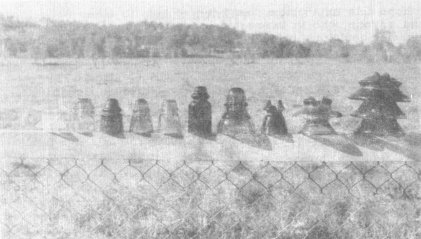Australian Glass Insulators
by Allman L Baker
Reprinted from "INSULATORS - Crown Jewels of the Wire", September 1971, page 14
A few months ago I moved to Australia from Warren, Ohio and began collecting
Australian insulators and information about them. There can't be more than a
dozen collectors on the entire continent, and consequently competition is
non-existent. By nature Australians are friendly and helpful people, and
gathering Insulators Is about as hard as falling off a log. The telephone
company, operated by the Postmaster General's Department of the government, was
happy to find someone who would carry the things off and save them the trouble
of dumping them. And the power company went so far as to send line men up poles
to get me samples no longer in stock. Power and communications lines are going
under ground here much faster than they are in the U. S. In the Brisbane area
alone this year they have pulled down and dumped over 300,000 insulators, so I
don't think it will be long before this insulator collector's paradise will be a
desert.
Prior to 1930 all insulators used in Australia were imported, the majority of
them from Europe and Britain, but some came from the U. S. , which explains the
Floys that are supposed to be here, although the only U. S. insulators I've seen
here are the ones I brought with me. However, I am still looking, and I'm
planning a trip to look at a telegraph line which was erected in the late 1860's
with, I am told, U. S. Insulators.
In 1931 the Australian Glass Manufacturing Co. of Sydney began production of
glass Insulators and continued until 1948. The insulators produced during this
period carried the trade name AGEE. In 1948 production was transferred to a
subsidiary company, Crown Crystal Glass, also located in Sydney. These
insulators carried the legend CCG. Two years later, in 1950, production
facilities were again moved, this time to Hobart. From 1950 until production
ceased In 1962 the Insulators bore the letters AGM.
Australian Glass Manufacturers and Its subsidiaries produced Insulators
primarily for the P.M.G., and since specifications were supplied by the P.M.G.
there Isn't a wide range of designs. I have found only eight different types.
Colors, however, are another story. Amber was the most popular color with the
P.M.G. But since it is desirable in glass production to continue a run of one
color as long as possible, the P.M. G. often accepted insulators in whatever
color was being run. Consequently, I have found Aussie Insulators in clear,
peach, straw, light green, dark green, smoke, gray, amethyst, amber and purple.
The. purple Insulators are not sun colored, but are the result of a run from an
experimental tank color change.

The Insulators in the photograph show the 8 Aussie types and 2 of the
imported French ones. From left to right: Spool embossed AGM, clear; Toll
embossed AGEE or no name, green and amethyst; Modern Pony embossed CCG or AGM,
It. green, amber, clear, straw, peach; Modern Pony, slightly different shape,
embossed AGEE, clear, smoke gray, and purple; Flat top Modern Pony, nickname
"Tee Pee", embossed AGEE, purple; Toll signal type, nickname "Pop
Bottle", embossed AGM or CCG, amber, amethyst, clear, straw and It. green;
Bell shaped signal, nickname "Big Joe", embossed AGEE, clear, smoky
gray and purple; Cable embossed AGM comes in clear, It. green and amber. The two
on the right are French, embossed L'Electro Verre, and come in dark green.
The Insulators in some Instances carried dates of manufacture on the back,
e.g. 1949 = 49, or one digit and some dots. In this case the digit refers to the
decade, and the dots each subsequent year, e.g. 1954 = 5.... Any other numbers
refer to the mold numbers, and they are usually found on the front.
There are no glass insulators being produced here now, but the State
Electricity Commission has informed me that some green 10 inch diameter disk
Insulators are being imported from a French company known as Sediver Pilkington
International. Before the power companies started underground they used a lot of
French glass. These insulators are all green, made In two or three sections,
depending on size, cemented together and have a copper insert for threads. They
carry the legend L'Electro Verre and range In size from 4" high and 5-1/2"
wide to 8" high by 9" wide. Most imported insulators, though, are
porcelain and seem to come from everywhere. I have found porcelain here made in
Australia, New Zealand, Japan, Hong Kong, Mainland China, France, Britain, and
even India.
I hope this information has been of help to other collectors, and anyone who
is interested in or has any questions about Aussie insulators or just Australia
in general can write me.
Allman L. Baker
P.O. Box 173
Burleigh Heads
Queensland Australia 4220
|
